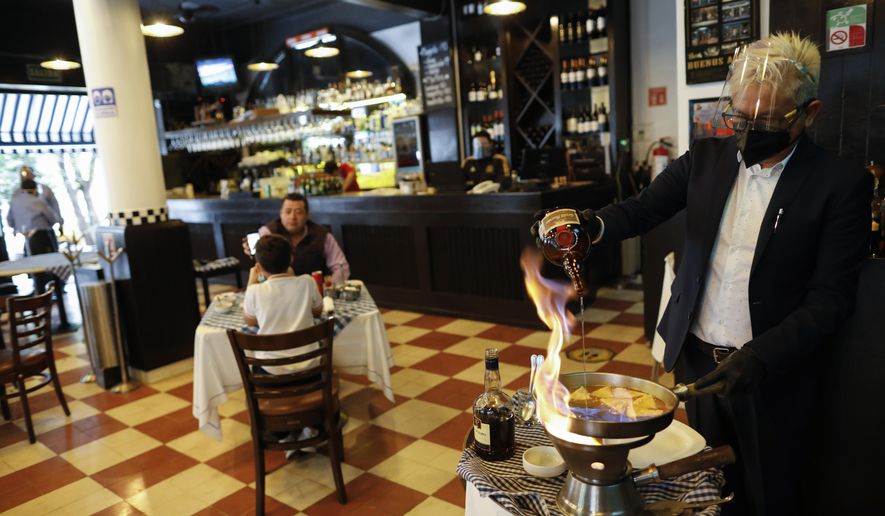MEXICO CITY (AP) - More than three weeks into Mexico City’s second pandemic shutdown some restaurants ignored official warnings and opened with limited seating Monday under the slogan “Open or Die.”
This second shutdown has been even more painful for restaurant owners and their staffs. Ten months into the country’s epidemic they have already burned through savings, renegotiated leases and reduced employee hours, all the while operating at a loss.
They had regained some footing by fall as a wary public gained a degree of comfort with eating out in reduced-capacity restaurants. But the forecast winter climb in infections hit just as people lowered their guard and in many cases attended gatherings during the holiday season.
Now employers have fewer options beyond laying off workers, and a drive down almost any street displays shuttered storefronts and for rent signs.
“We’re at the limit,” said restaurateur Giulliano Lopresti, who reopened his Argentine restaurant Quebracho on Monday. “Not having certainty to operate during the ‘red light’ (restriction phase) is condemning businesses, the restaurants to close.”
The Mexican government has not provided assistance to small businesses like in the United States. Mayor Claudia Sheinbaum has touted a one-month reprieve on payroll taxes, but Lopresti said that is the one area that least worries employers.
There has been no break on social security payments for workers and he doesn’t want to leave his employees without insurance. Multiple owners said the government-owned electric utility has been worse than ever to work with, closing its offices and making it nearly impossible to contest exorbitant electric bills.
In mid-December, faced with filling hospitals, Mexico City returned to its red alert, suspending restaurants’ limited seating and returning to takeout and delivery only. Hospitals in the capital, Mexico’s COVID-19 epicenter, were at 92% capacity.
On Monday, the mayor said that hospitalizations had been surging for the past four days and that health workers were investigating the cause. Experts had warned that gatherings during the holidays would lead to increasing infections.
“The greatest number of infections occur in closed spaces where masks are not used and safe distance is lost,” Sheinbaum said, adding that city officials did not want to impose the restaurant restriction, but they are trying to reduce the number of infections.
Asked specifically about restaurants that opened Monday, she said they would be sanctioned with fines or even closed.
“We are at the highest peak of hospitalizations since the start of the pandemic and it keeps rising,” she said via Twitter later.
Restaurant associations have proposed guidelines that would allow them to operate while the capital remains on red alert, including 25% capacity indoors and 35% outdoors, tables of no more than six and earlier closing times.
On Monday, diners filled 10 outdoor tables and more waited in line at the Sonora Grill, an upscale steakhouse on one of Mexico City’s main boulevards. Restaurants with table service observed by The Associated Press were checking diners’ temperatures, providing hand gel and sanitizing tables.
Eating lunch at Quebracho, accountant Carlos Weinberger said restaurants should be allowed to open. People are traveling and the virus is everywhere, so restaurants shouldn’t be singled out, he said.
Authorities are failing to balance health concerns with economic ones, he added. “We die from coronavirus or from hunger,” he said.
In Coyoacan, a charming Mexico City borough, a number of restaurants around its central plaza hung signs threatening to open Monday, but in the end stuck with takeout service only.
Gabriel Barragan Ortiz, the head waiter at Cabo Coyote, said they decided to wait for the city’s response to their threat to reopen, but hoped the government would recognize their plight.
“Many of us, the first time, had a bit of savings, someone we could ask to borrow money, a relative who could help us, but the situation now is more difficult,” Barragan said.
Lopresti and others said they just cannot survive on their takeout business. He said his restaurants made only 1% to 3% of their usual sales with takeout. He published an open letter explaining his reasons for reopening and started an online signature campaign to pressure the government.
“If I’m going to die or my restaurant is going to close and I’m going to go bust, I prefer to do everything possible” rather than go down with the doors closed, Lopresti said.
Mireya Ruiz built a single restaurant, Casa de la Yeya, serving low-cost traditional Mexican dishes into a chain of 10 places over 29 years. During the pandemic she has had to close three, and two more are on the verge, she said.
Ruiz hasn’t fired anyone but nearly half of her employees have left because she can’t give them enough hours of work to survive.
“My people are doing really badly, and every day we lose more positions,” Ruiz said through tears. “We’re desperate and they aren’t helping us.”
__
AP journalists Lissette Romero and Rebecca Blackwell contributed to this report.




Please read our comment policy before commenting.